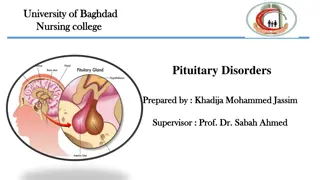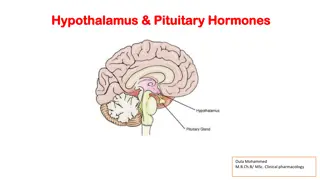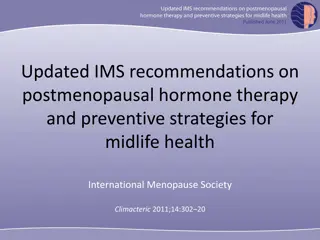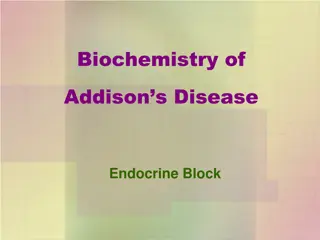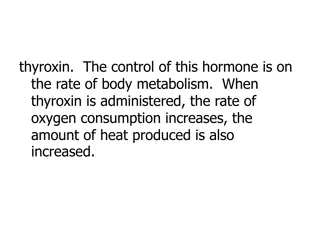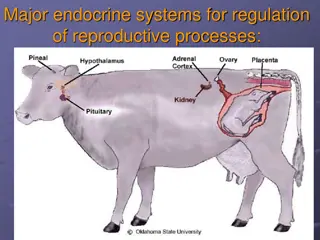
Hormone-Receptor Interaction: Mechanisms and Biomedical Importance
Explore the intricate relationship between hormones and receptors, delving into mechanisms of action and the biomedical significance of disruptions in hormonal pathways. Understand factors influencing cellular responses to hormones and the classification of hormones based on their actions.
Download Presentation

Please find below an Image/Link to download the presentation.
The content on the website is provided AS IS for your information and personal use only. It may not be sold, licensed, or shared on other websites without obtaining consent from the author. If you encounter any issues during the download, it is possible that the publisher has removed the file from their server.
You are allowed to download the files provided on this website for personal or commercial use, subject to the condition that they are used lawfully. All files are the property of their respective owners.
The content on the website is provided AS IS for your information and personal use only. It may not be sold, licensed, or shared on other websites without obtaining consent from the author.
E N D
Presentation Transcript
By Dr. Amr S. Moustafa Clinical Chemistry Unit Pathology Department College of Medicine, KSU
OBJECTIVES By the end of this lecture, students should be able to: Acquire the knowledge for general consequences of hormone-receptor interaction Understand different mechanisms of action of hormones Recognize the biomedical importance due to disturbance in the normal mechanisms of hormonal action
Lecture Outlines Background Factors determining the response of a target cell to a hormone Hormone-receptor interaction General features of hormone classes Classification of hormones by mechanism of action Biomedical importance
Background Multicellular organisms depend in their survival on their adaptation to a constantly changing environment Intercellular communication is necessary for this adaptation to take place Human body synthesizes many hormones that can act specifically on different cells of the body
Background More than one hormone can affect a given cell type Hormones can exert many different effects in one cell or in different cells A target is any cell in which the hormone (ligand) binds to its receptor
Factors determining the response of a target cell to a hormone The rate of synthesis & secretion of the hormones The conversion of inactive forms of the hormone into the fully active form The rate of hormone clearance from plasma (half- life & excretion) The number, relative activity, and state of occupancy of the specific receptors Post-receptor factors
Stimulus Hormone release Group II hormones Group I hormones Hormone/receptor binding at the target cells Recognition Signal generation Hormone-receptor complex Second messengers Effects Gene Transporters, channels Protein translocation Protein Modification transcription Coordinated response to stimulus
General Features of Hormone Classes Group I Group II Types Steroids Thyroid Hs (T3 & T4) Calcitriol, retinoids Polypeptides Glycoproteins Catecholamines Lipophilic Hydrophilic Solubility Yes No Transport proteins Long (hours days) Short (minutes) Plasma half-life Intracellular Plasma membrane Receptor Mediator cAMP, cGMP, Ca2+, metabolites of complex phosphoinositols, tyrosine kinase cascades Receptor-hormone complex
Classification of Hormones by Mechanism of Action I. Hormones that bind to intracellular receptors (Steroid-Thyroid superfamily): Steroid hormones Thyroid Hormones (T3 & T4) Calcitriol (active form of vitamin D, 1,25[OH]2-D3) Retinoic acid
Classification of Hormones by Mechanism of Action continued II. Hormones that bind to cell surface receptors A. The second messenger is cAMP Catecholamines ( 2- Adrenergic) Catecholamines ( - Adrenergic) Ant. Pituitary: ACTH, FSH, LH & TSH ADH (Renal V2-receptor) Calcitonin & PTH Glucagon
Classification of Hormones by Mechanism of Action continued II. Hormones that bind to cell surface receptors B. The second messenger is cGMP Atrial natriuretic peptide (ANP) Nitricoxide
Classification of Hormones by Mechanism of Action continued II. Hormones that bind to cell surface receptors C. The second messenger is calcium or phosphatidylinositol (or both) Acetylcholine (muscarinic) Catecholamines ( 1- Adrenergic) Angiotensin II ADH (vasopressin): Extra-renal V1-receptor
Classification of Hormones by Mechanism of Action continued II. Hormones that bind to cell surface receptors D. The second messenger is a tyrosine kinase cascade GH & Prolactin Insulin Erythropoietin
Mechanism of Action of Steroid-Thyroid Hormones Steroid Hormones: Glucocorticoids Mineralocorticoids Sex hormones: Male sex hormones: Androgens Female sex hormones:Estrogens & Progestins Thyroid Hormones (T3 & T4) Calcitriol (1,25[OH]2-D3) Retinoic acid
Glucagon Catecholamines ( - Adrenergic) ADH (Renal V2-receptor)
Cascade for formation of cAMP by cell-surface hormones
Actions of cAMP 1 AMP 1Phosphodiesterase
Abortion of Hormonal Stimulus 1. Release of hormone from its receptor (unbound receptor) 2. Dephosphorylation of protein substrate by phosphatase 3. Degradation of cAMP into AMP by phosphodiesteras 4. Inactivation of protein kinase A by a decrease of cAMP 5. Hydrolysis of GTP into GDP 6. Binding of -subunit to -subunits 7. Inactivation of adenylyl cyclase
Group II. Hormones that bind to cell surface receptors B. The second messenger is cGMP
Atrial Natriuretic Peptide (ANP) GC: Gunaylate cyclase
Catecholamines (1-Adrenergic) ADH (vasopressin): Extra-renal V1-receptor
Calcium/Phosphatidylinositol System Diacylglycerol (DAG) Phospholipase C Inositol Trisphosphate (IP3)
Growth hormone and prolactin Insulin Erythropoietin
Biomedical Importance Excessive (e.g., hyperthyroidism, Cushing), deficient (e.g., hypothyroidism, Addison), or inappropriate secretion (e.g., syndrome of inappropriate secretion of ADH SIADH ) of hormones are major causes of diseases Pharmacological treatment of these diseases depends on replacement of deficient hormone (hypo-) or use of drugs that interfere with the mechanism of action of the hormones (hyper- or inappropriate)



